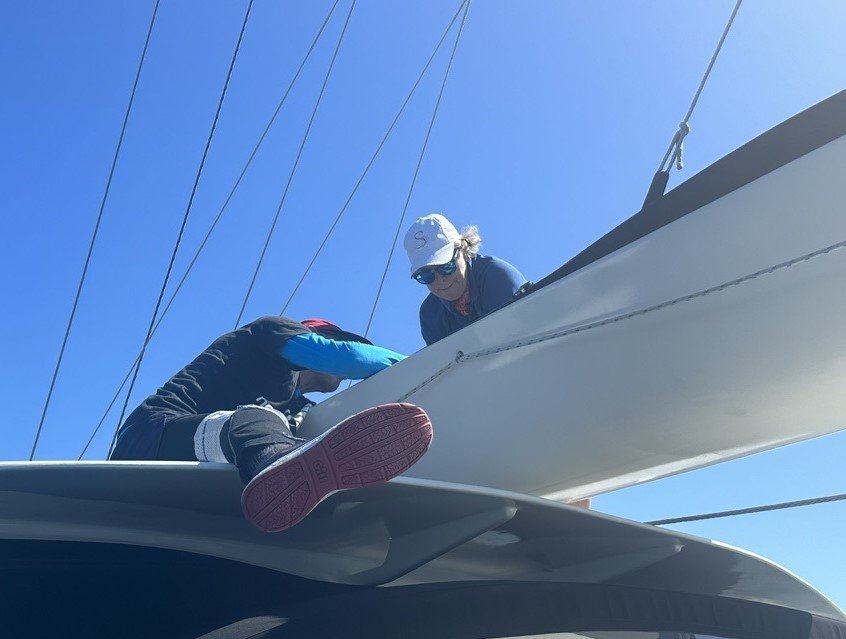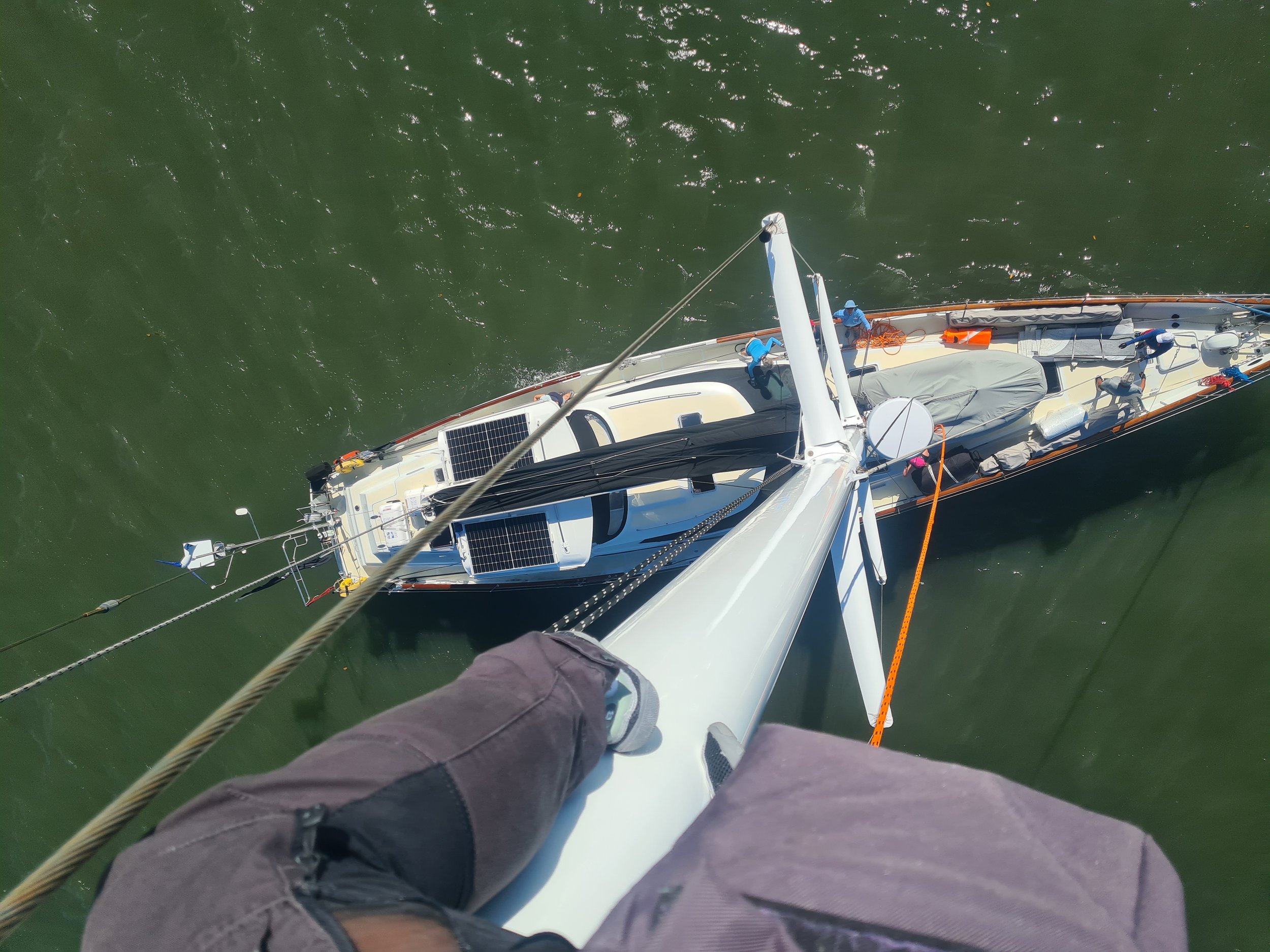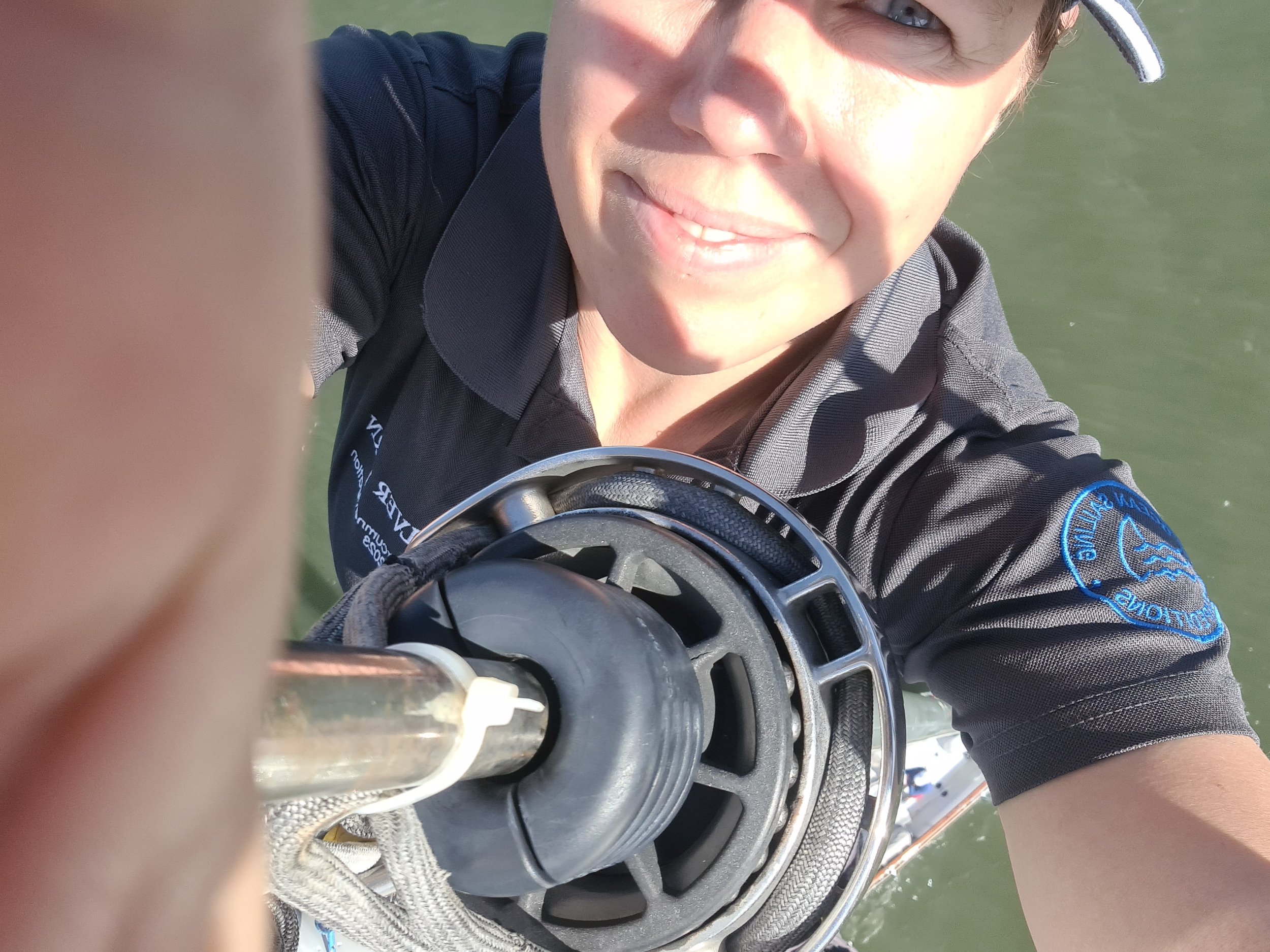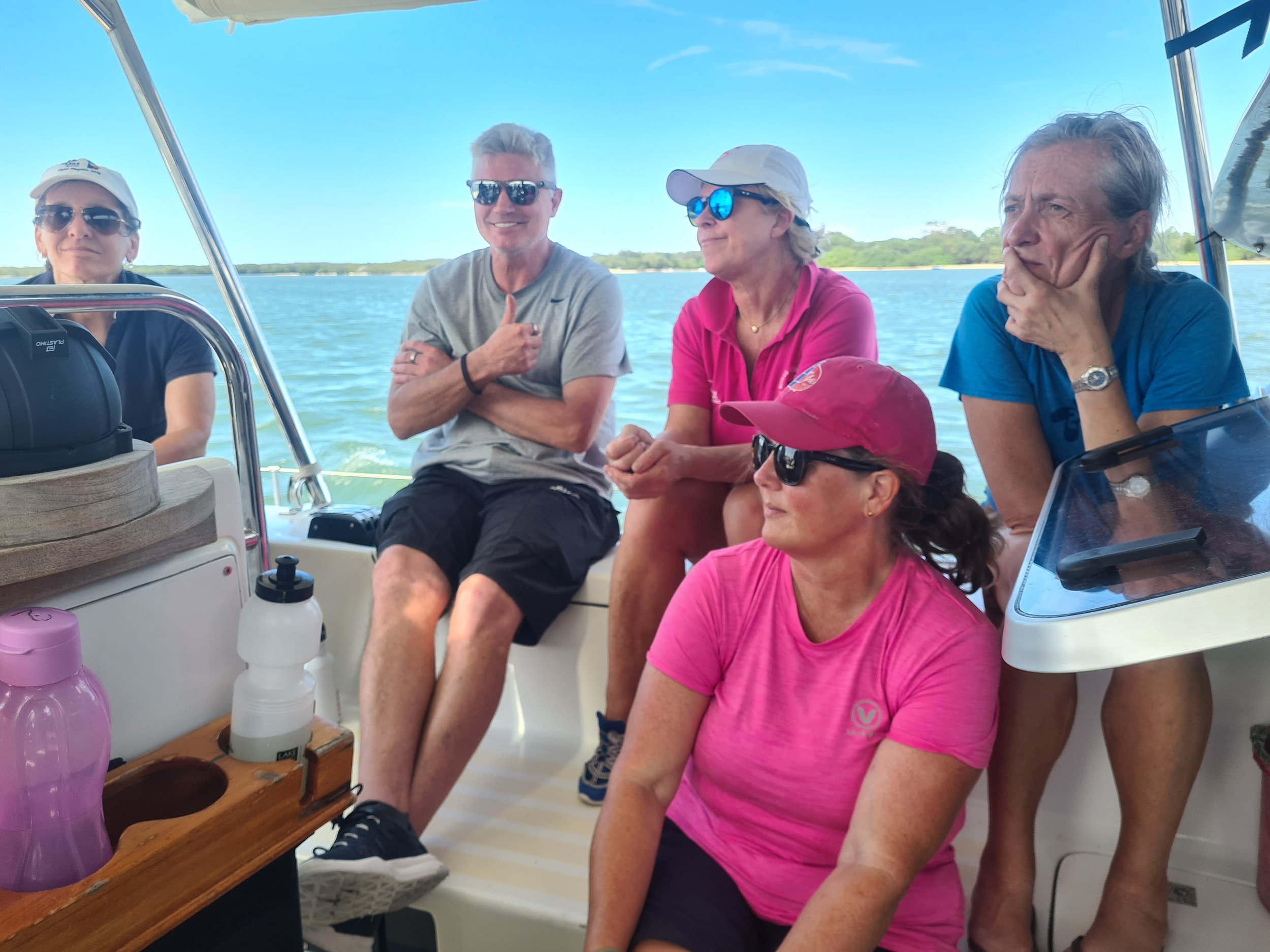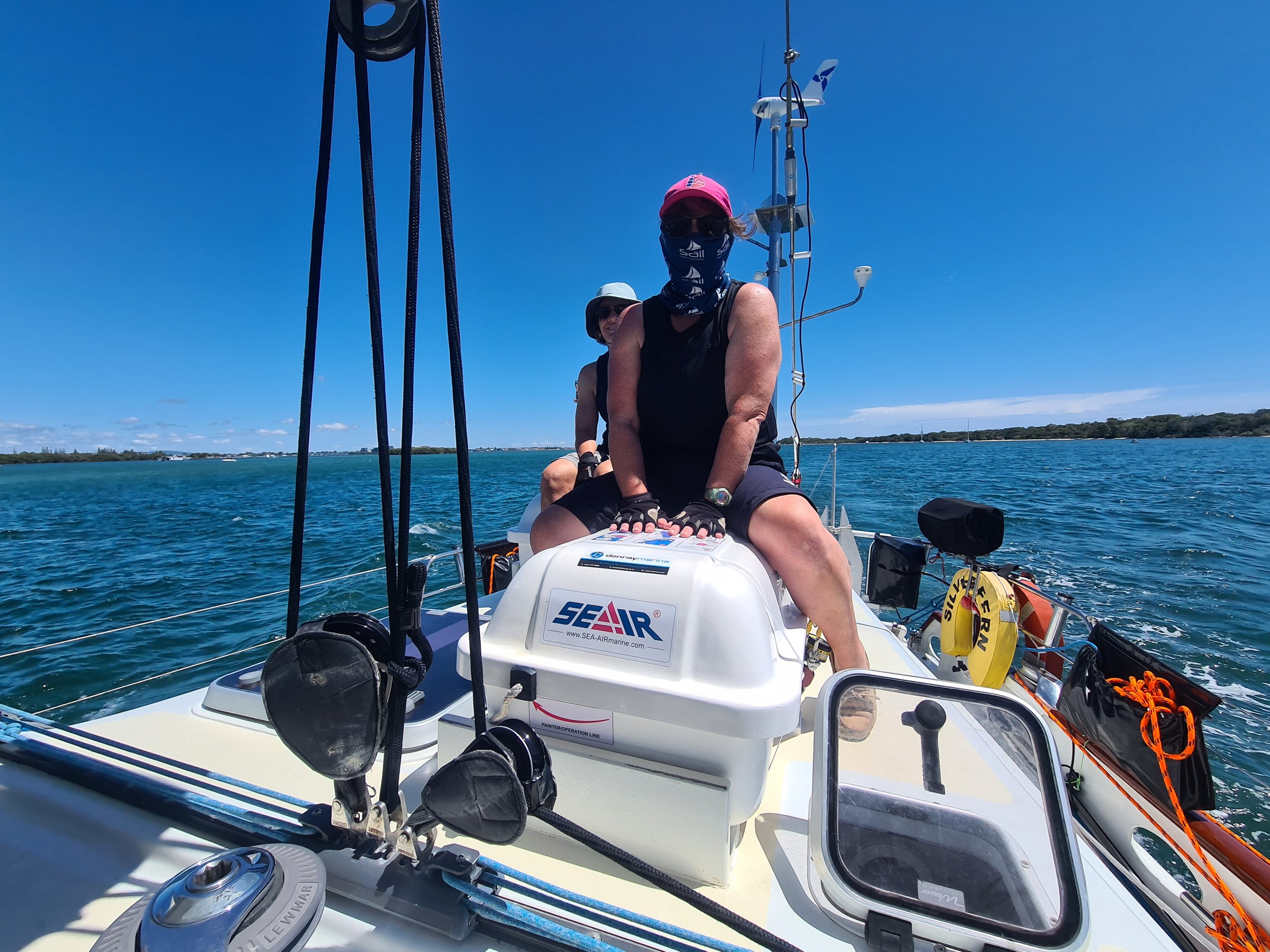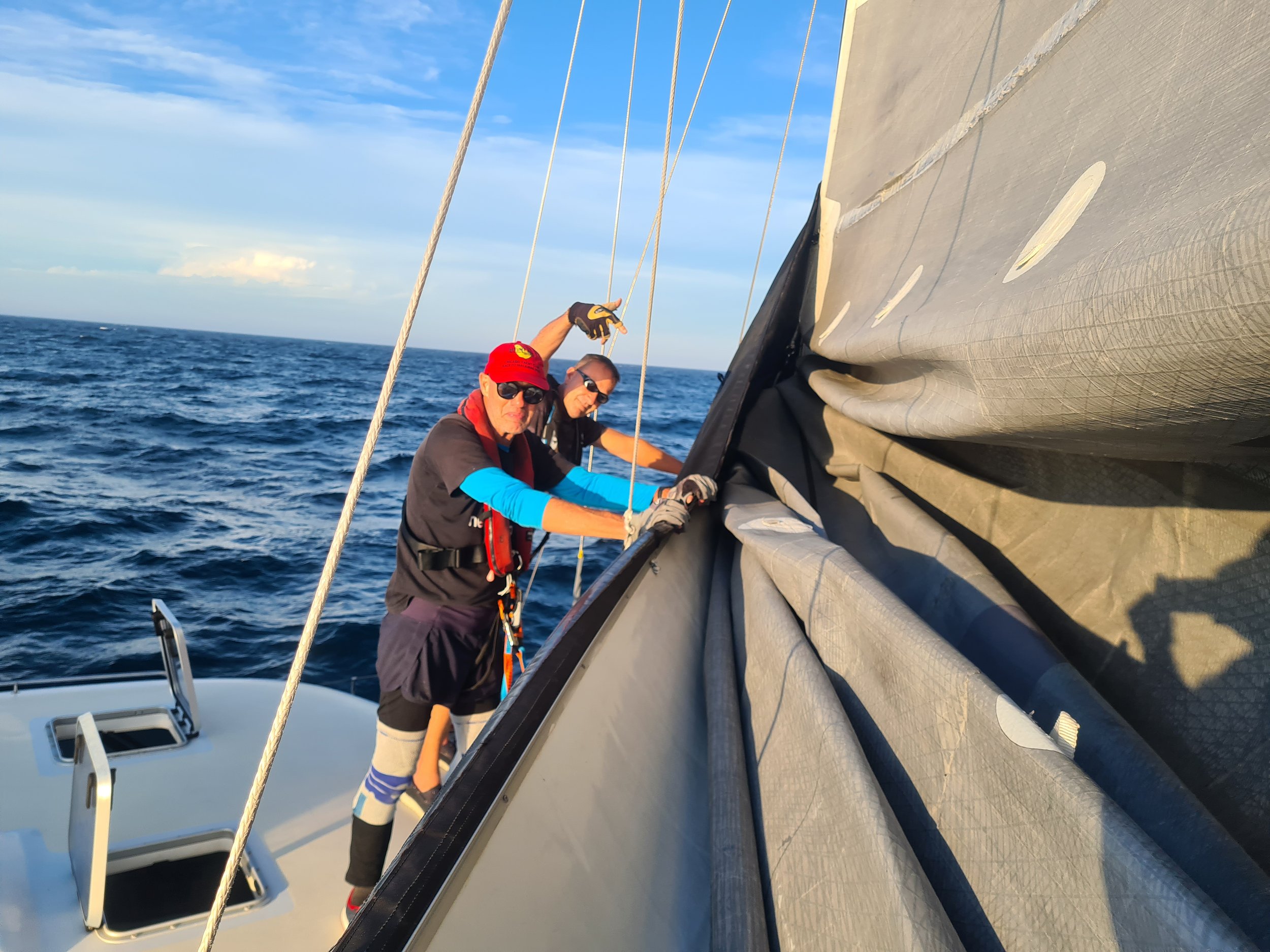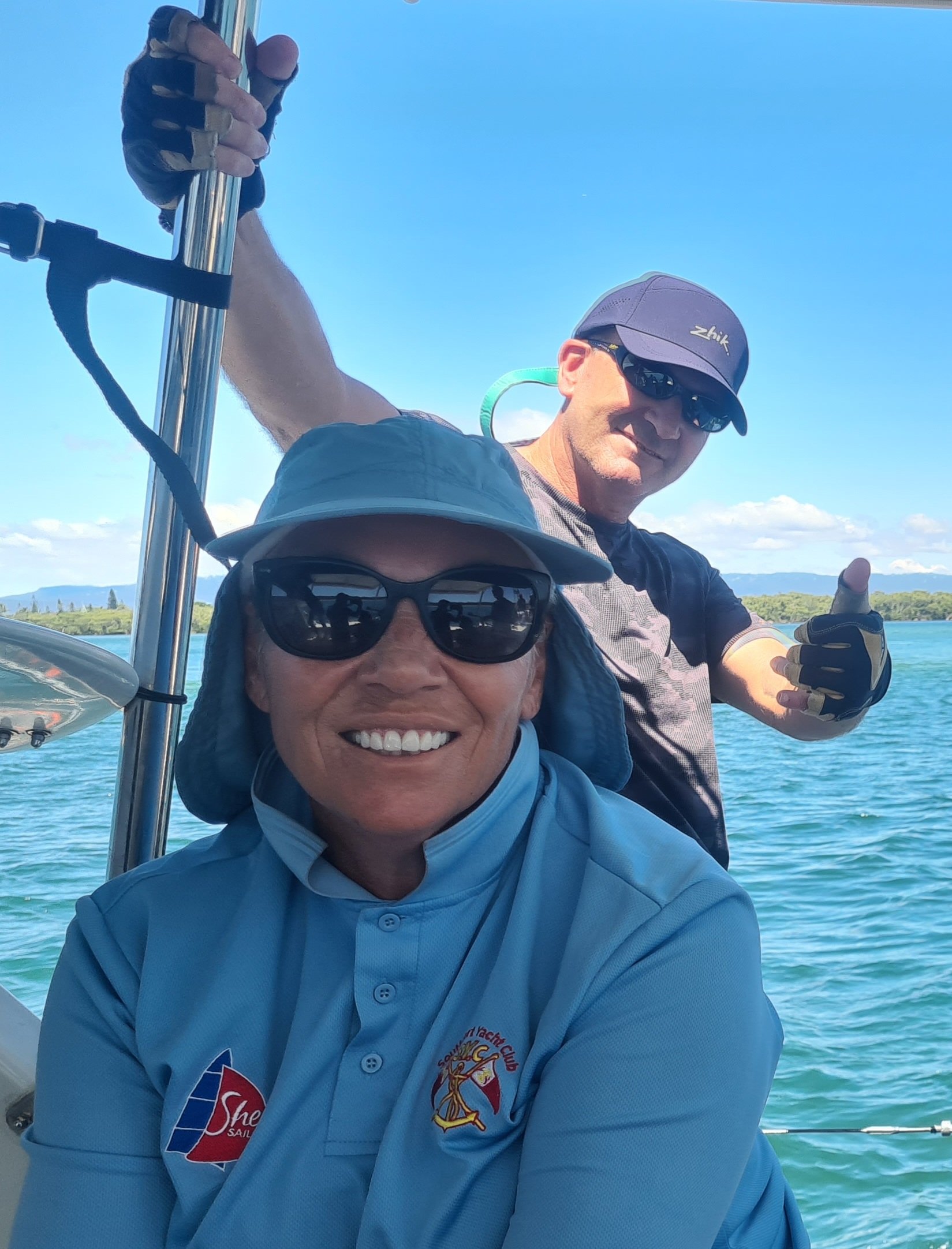Training weekend for Sydney to Hobart
Peter and Jo working away on the boom
As the circumnavigation of Australia is complete, Silver Fern is in for some maintenance and repair jobs. There is much to be done after this year's sailing which added up to about 15,000 nm. Also, there are some specific jobs to be done in order to prepare for this year's Sydney to Hobart race.
The schedule for the boat work had to be carefully managed as Silver Fern was to be heading back to sea less than two weeks after arrival to Gold Coast City Marina. The 2023 Sydney to Hobart racing crew met up for a weekend of training on board. The plan was to go a bit offshore and do an overnight passage.
Getting those winches ready
As the last of us were arriving, lots of the jobs on board were being finished up. Finally the parts for the winches were fitted and we were good to go.
Skipper David and his crew gathered in the cockpit
Jo and Matt. Finally getting under way!
There was no breeze in the marina, and the sun was up high, baking us in mid-day heat of about 35 degrees. That was a bit hot even for the Aussies - and definitely for me, being from Sweden. We decided that the safety briefing and some initial training could be carried out in Broadwater, where there should be a bit more breeze. A few other jobs could also be done there, like the rig inspection and replacement of the main batten casing that was cracked under too much pressure when we were reefing during the last leg.
Getting the batten car in place
Rig inspection - Nat working the safety halyard from the deck, Marzena helping her tail, and Peter discussion the next job to be done with David
This is me saying hi from the sky! Securing the furler away on top of the stay, as we will not be usung the furling genoa.
Normally, the safety briefing takes about three hours. There are a lot of points to walk through, from the safety equipment to the safe operations of the galley. We did that while motoring, and then prepared for anchoring for the night.
Sarah, Matt, Jo, Linda and Marzena at maximum focus as we walk through the external safety
Peter, Andrew, Nat and Dario listening attentively
Liferaft walk-through, Nat showing the deploying precedure, Salt Lines just behind us
Our skipper Dave doing the driving
Just as we were finishing up the safety briefing on anchor in Broadwater, the thunderstorms rolled in and forced us to close all the hatches, contributing to even more stuffy air inside. All fans on, we made dinner and talked through tomorrow's plans.
Evening thunderstorms approaching
Everyone was in their bunks early, making sure they were rested before the early morning's sailing. 12 out of 15 crew members were present, and sleeping at the same time - so all bunks were full and both of the sofas in the saloon also had to be used. Any plans for sleeping in the cockpit while on anchor were promptly abandoned because of heavy rain from the thunderstorms - and heavy mozzie attacks as soon as the rain stopped.
The morning woke us with a beautiful breeze and a hot rising sun. Everyone was eager to go sailing, so after a quick coffee and breakfast (and a few more jobs) we weighted anchor.
Linda and Sarah on the lookout for adventure
Sarah enjoying the beautiful morning
Mark and Dario in matching outfits for the day
Soon, we were out of the Seaway, putting the sails up. The seas were flat, the sky was blue, and Silver Fern was out sailing again, together with Salt Lines!
The dolphins, too, came to say hello
We ran through a few maneuvers and let the team get familiar with the boat. The crew took turns at different tasks such as helming, trimming, bow, mast but also the galley and the cleaning duties. All the tasks on board are shared between the crew when we are sailing, and everyone is expected to pitch in where needed - naturally with instructions and some help if required.
Sarah and Linda on the bow
Peter and Andrew on the boom
Andrew on the helm, backed by Mark and Dario
Nat and Andrew on the trimming
Peter on the bow
Coast enveloping in haze as the heat intensifies
The sun and the heat were getting stronger as midday was approaching. At one point, one of the crew unfortunately got affected with heat exhaustion after some intensive physical work at the mast. The good thing was that we recognised the symptoms pretty fast. If not treated, heat exhaustion can develop into a more serious condition. It always varies depending on the individual - the hydration levels prior to heat exposure, the acclimatisation to the heat, any other things going on in the body like medical conditions, medication or any alcohol residue from days before, and of course individual response.
The best remedy for heat stroke is to try and cool down, stay in shade, rehydrate - possibly with an electrolyte drink - and avoid physical effort. However, as nausea is one of the symptoms, it may be difficult to keep hydrated. It soon became clear that medical advice should be requested. We have a possibility to talk to a doctor at all times. The doctor got the vital parameters and the patient's background, together with updated symptoms.
After receiving this, the doctor advised strongly towards medevac. In this situation, we need to make sure to follow the advice. Normally, most conditions can be treated on board. However, with more severe or complex situations, there will be a need external medical advice. Sometimes, the advice will be in favour of medevac in order not to risk further deterioration and bigger risk of impact on future health of the patient. Even though it may feel that you might be alright if you just sleep it off, following the medical advice is the wisest.
A small rescue vessel came out and the crew was successfully transported to a hospital. It took two full days' treatment, with some of the symptoms continuing still, and eight IV rehydration bags to get back to safe hydration levels.
As the rescue boat approaches, David is getting ready for the patient transfer.
Inside the rescue vessel, the patient is safe and sound.
After we were done with the sailing, we visited him in the hospital. He was feeling better, and was happy with the help he received. To avoid this in the future, he recommends the following:
Actively hydrating, the same day but also already the days before
Applying and reapplying sunscreen
Wearing sun protection hat and clothes
Managing body temperature, eg by staying in shade
We were missing our buddy on board, but there was still a lot of training to be done. We had dinner and then set up a watch system for the night.
As the darkness fell, more and more crew were discovering that they hadn't taken enough sea-sickness medicines. With the reasonably calm sea state it meant that doses have to be adjusted before Sydney to Hobart. I was handing out sick bags for anyone interested to keep in their pockets or bunks. The rule on Silver Fern is that when you are sea sick, you do not do it overboard. Not only is that dangerous, it's also not a pleasant or a hygienic way to take care of the situation. Neither is it comfortable, sustainable or hygienic to use the toilet. The sea sickness bags are of the same kind that are used in the hospitals and ambulances, they are handy and hygienic. It's the best way to handle the precarious situation that I've seen yet.
With the dinner in our tummies (mostly), the crew started the next stage of the training: night time kite sailing. It took a while to prepare the kite, partially because of the halyard getting jammed up on the mast. In the end, we used another halyard and proceeded. Finally, we were flying through the night. The stars were peeking out between the clouds, there was a gentle warm breeze and it was all dreamy and beautiful for a few hours - until a squall came and ruined all the kite fun. We stored it away and continued with helming practice well into the night, wind building until we had over 30 knots in the gusts. Still, it was nice sailing, with the moon playing hide-and-seek in the clouds and a bit of cargo traffic to watch out for. In the morning, the often unlit fishing boats with no AIS transmitters added to the challenge.
The sunrise brings out amazing sky colors - and the myriad of fishing boats
Nat working away at the cockpit after a late night watch
David at the helm, really wishing he was going across the Tasman - yet having to turn back to the marina for this time
We made sure everyone had a couple hours of sleep, and then went on with the training, together with a few jobs on the boat. As we came back to the dock, everyone pitched in to finalize all that was needed to be done for this time.
Crew collaborating to beautifully flake the sails
Preparing for removing the main
The lazy bag was removed for repairs, the mainsail was taken down for service, the furler genoa had to be put back (yeay, another trip up the mast for me!). The docking lines and the fenders were double-checked - there is a cyclone coming in towards Gold Coast in about a week's time and rhe boat needs to be safe.
Finally, the crew left off. Me and crew Nat stayed for a while to hose down the boat down (a very nice job in this heat), and a couple more things. Then she took me for a swim and a dinner with a view, while the boat would be undergoing more maintenance by contractors.
Just three buzy weeks left now before the race. This will include sailing Silver Fern from Southport to Sydney, another training opportunity for some of the race crew. I remember doung that last year in southerly winds - a choppy endeavour that definitely tried your endurance if you thought you were out for a quick and smooth delivery. Hope that they will have a safe passage, and they have all the possibilities to have a very educational and fun one. Skipper Sharon will be back on board together with Liam as the Chief Mate. I wish I could join myself, but it's time for me to be home for a while. I'll be back on Christmas day - see you in Sydney!
Lena, Chief Mate Silver Fern

